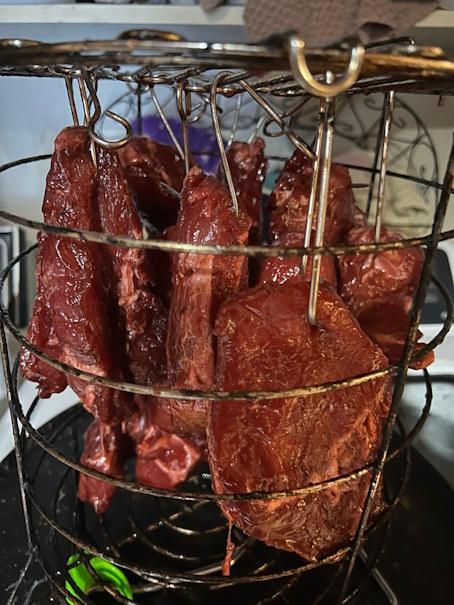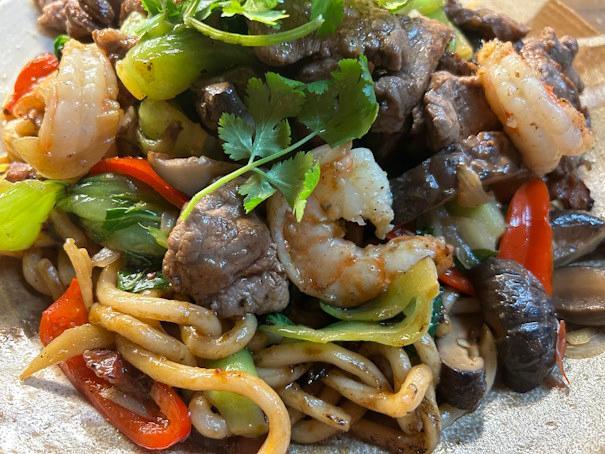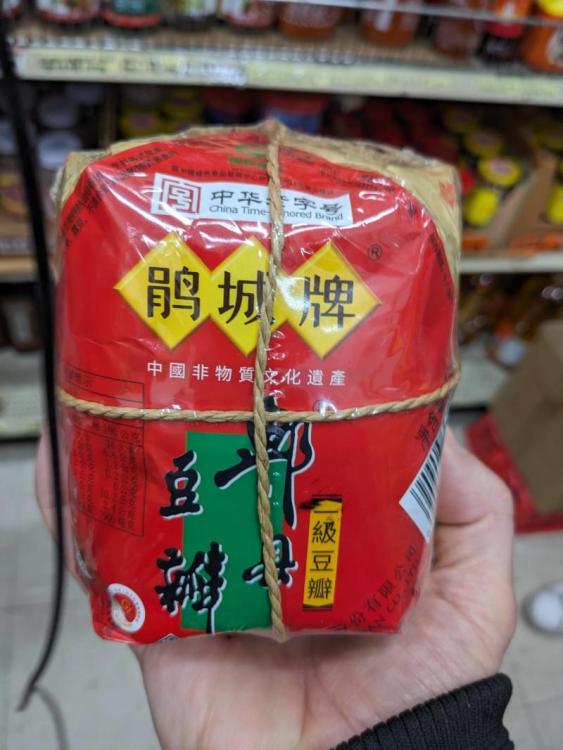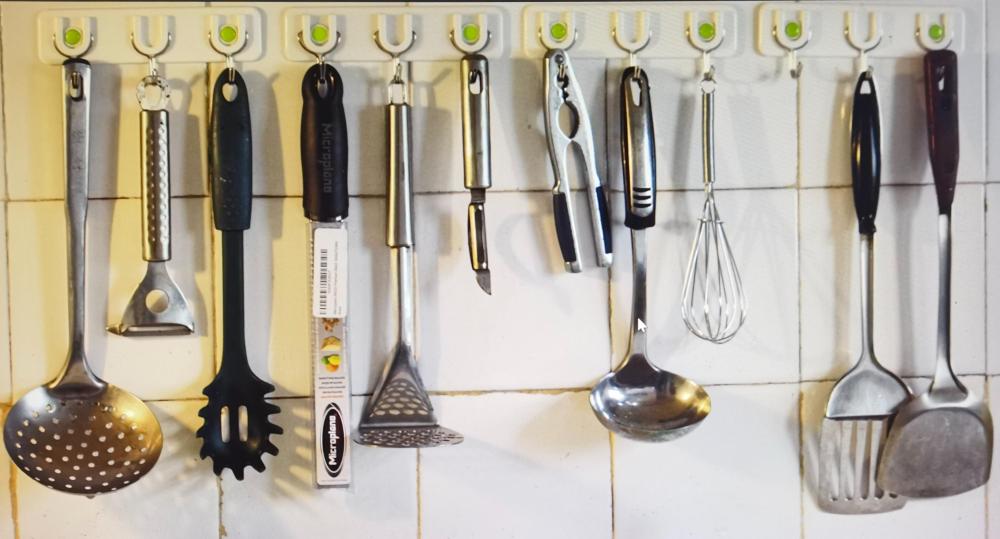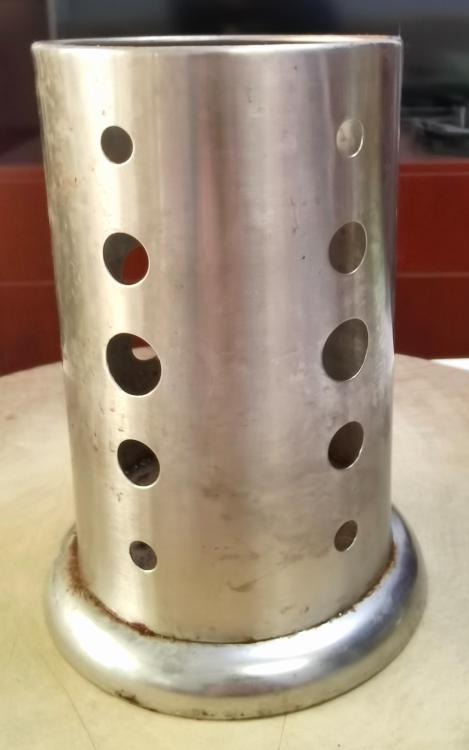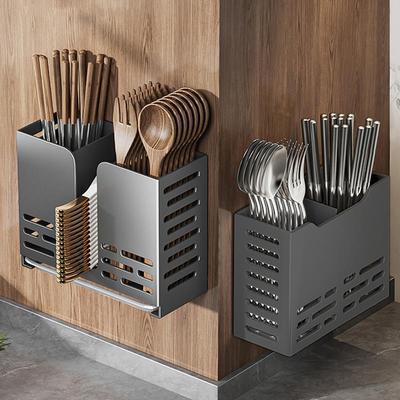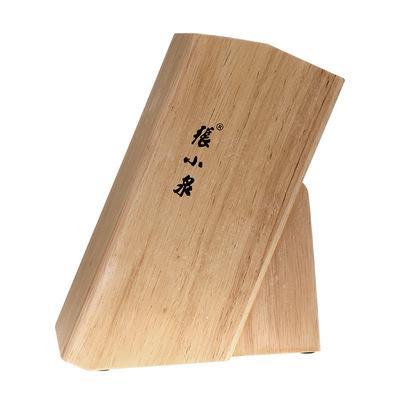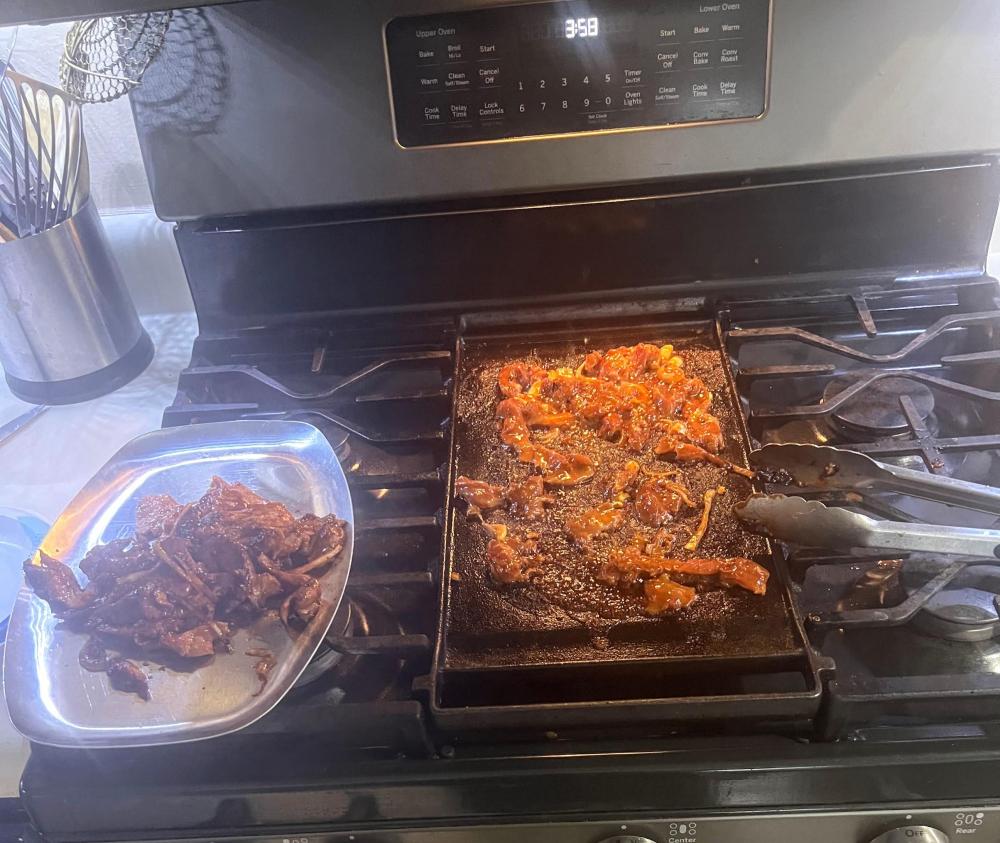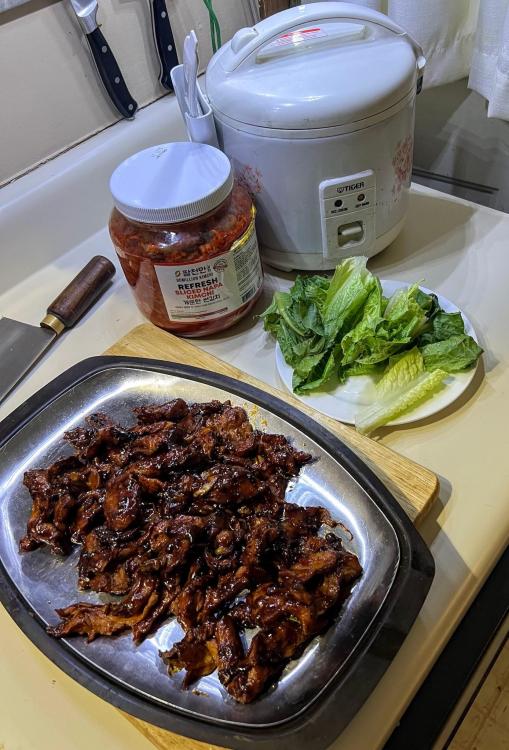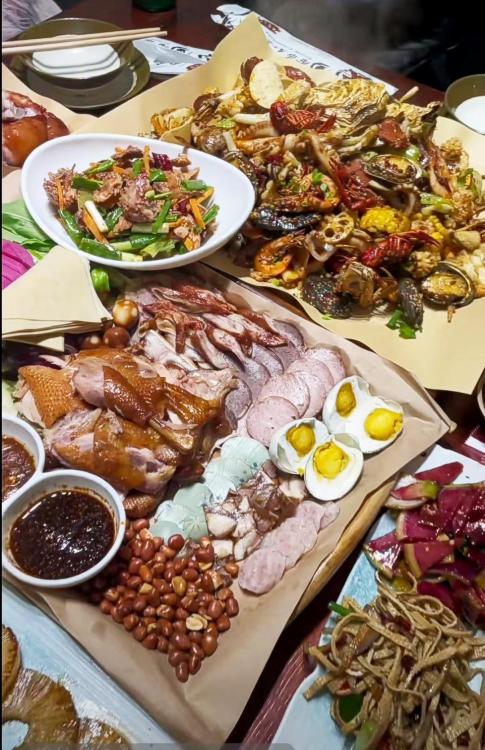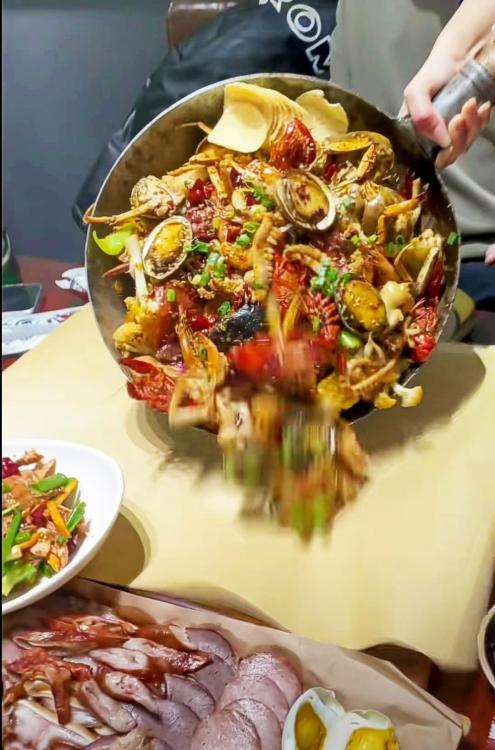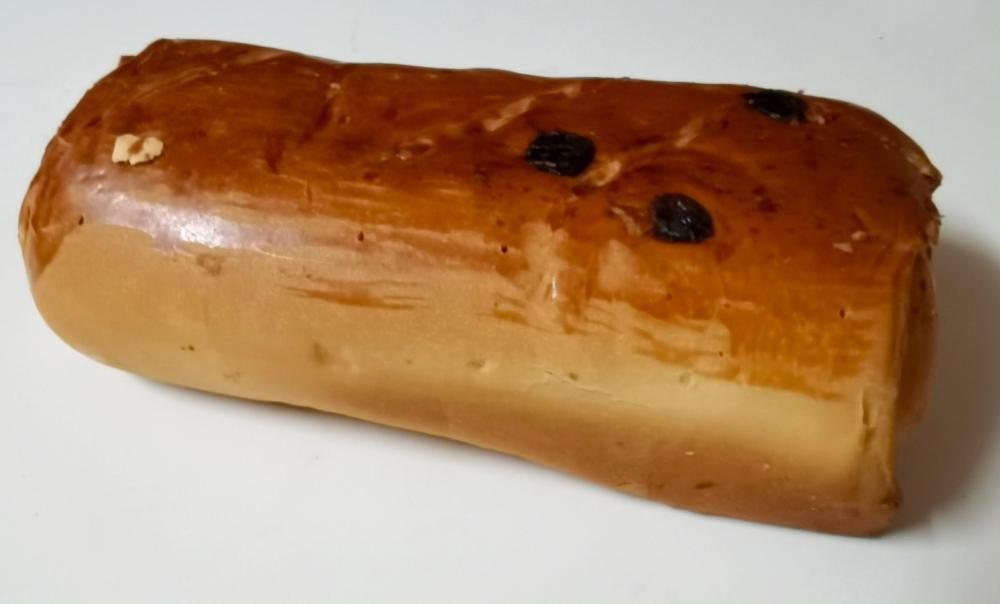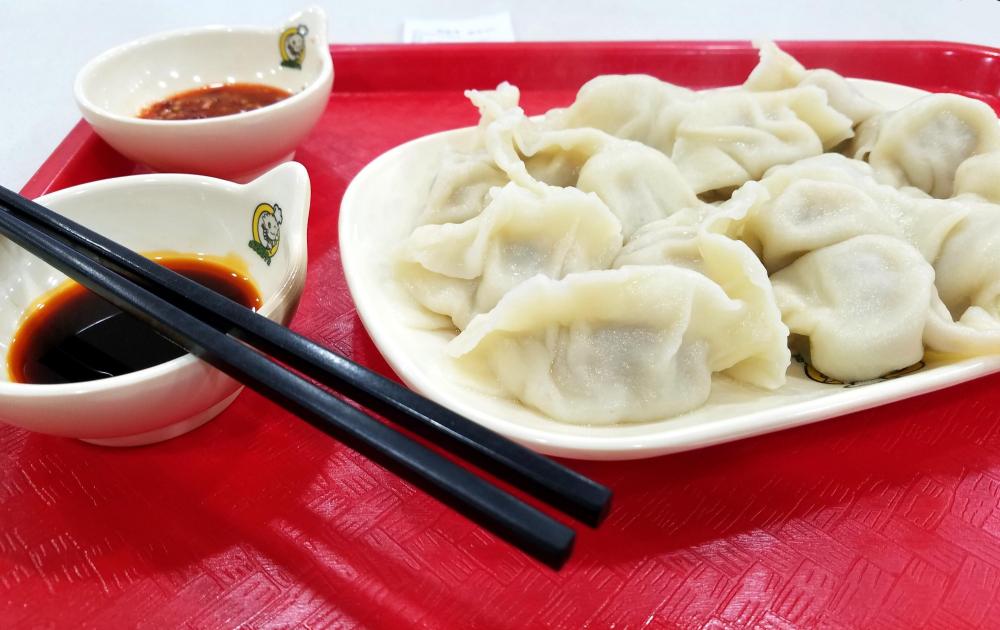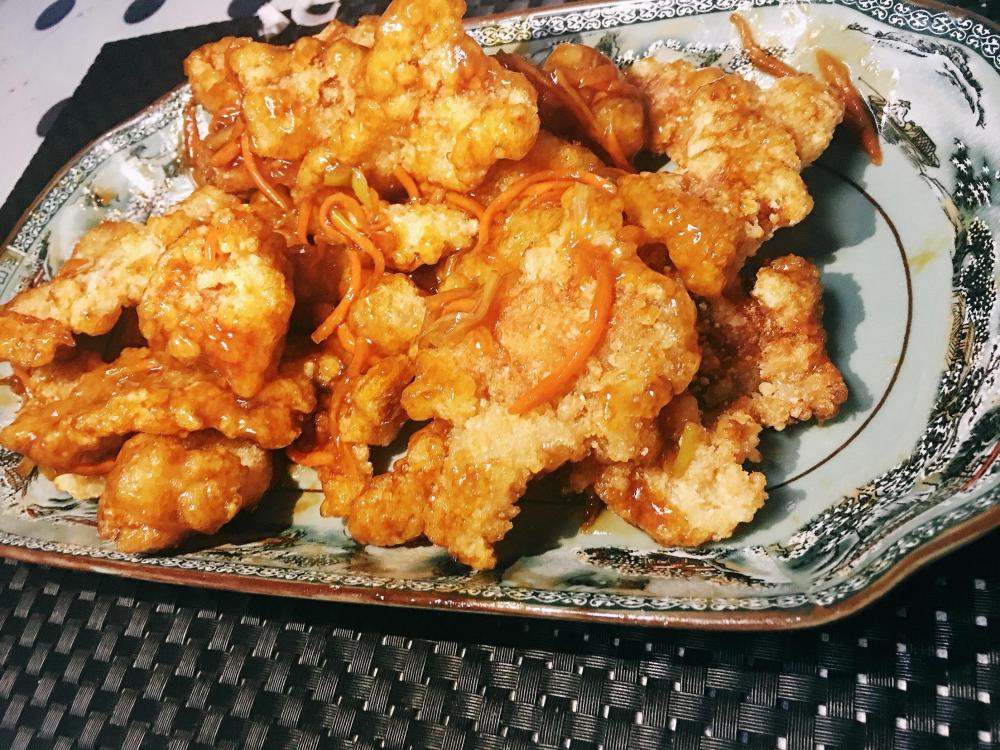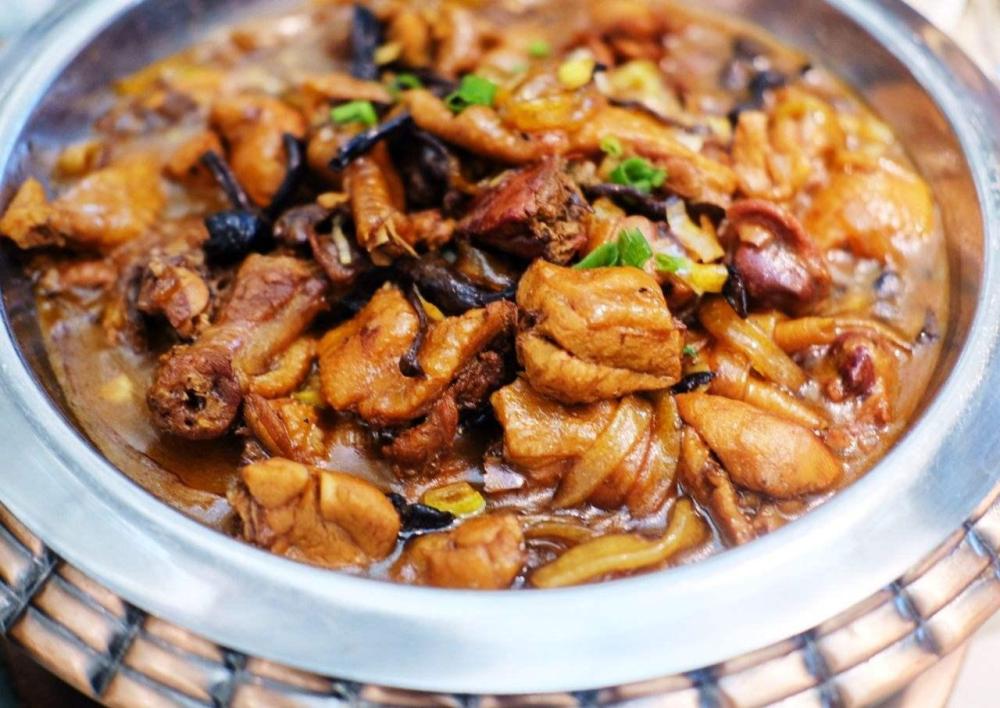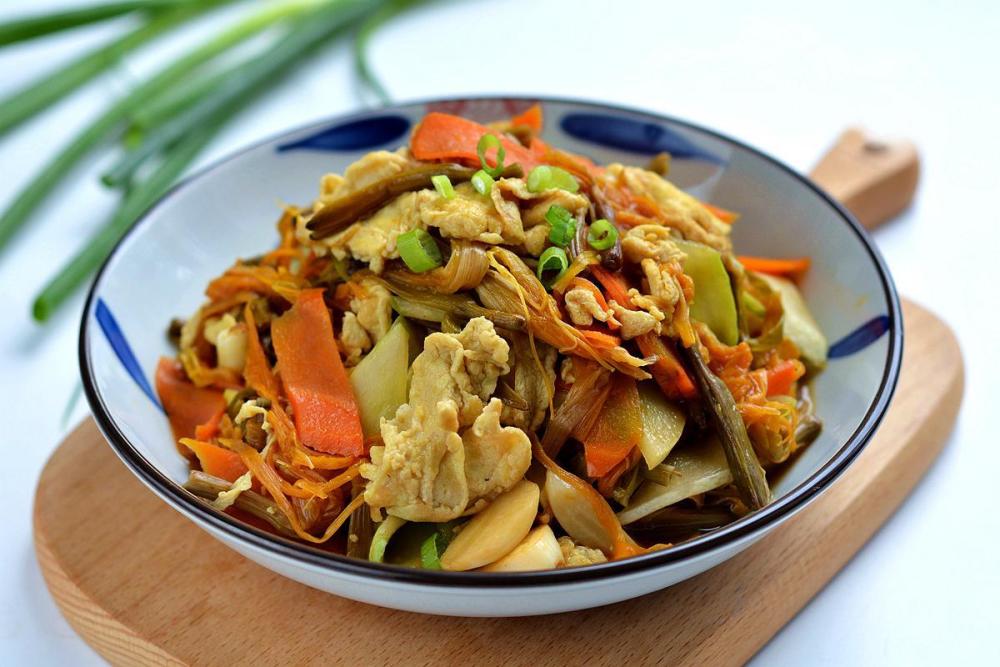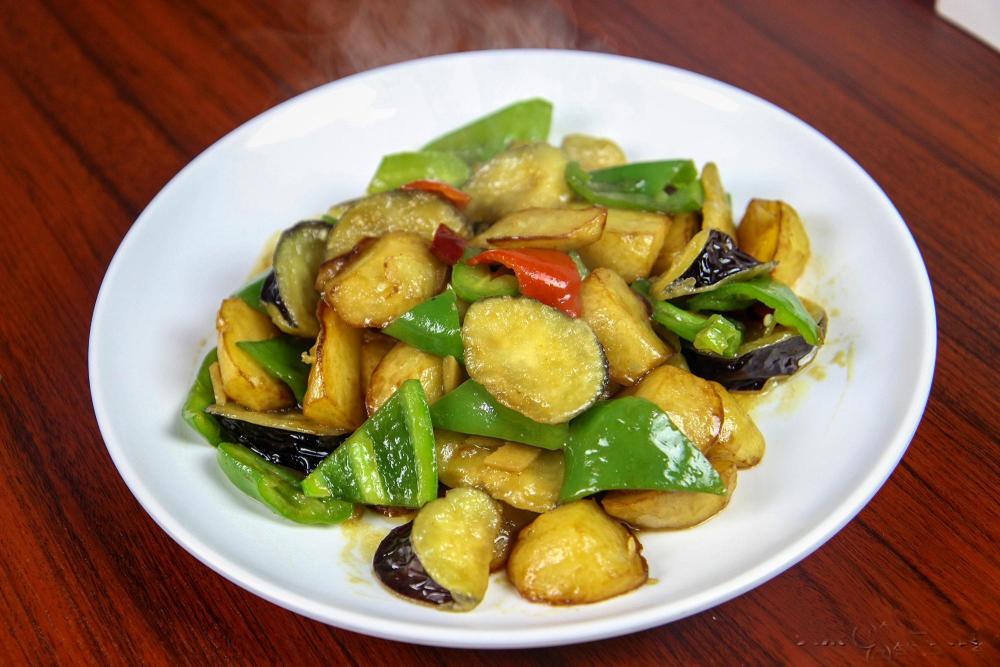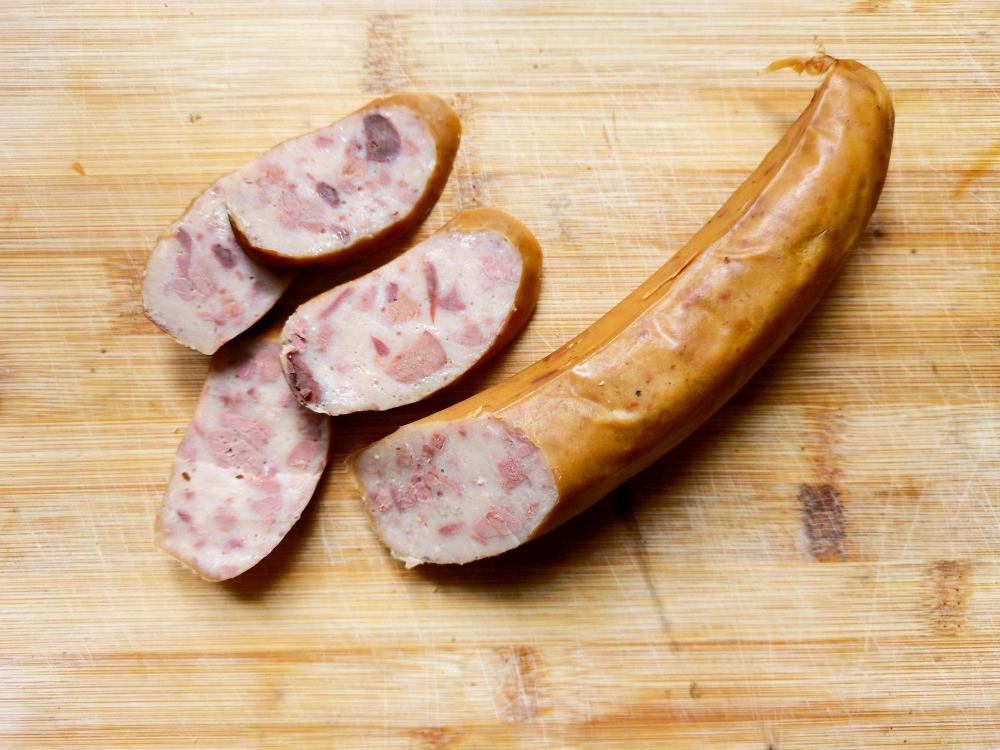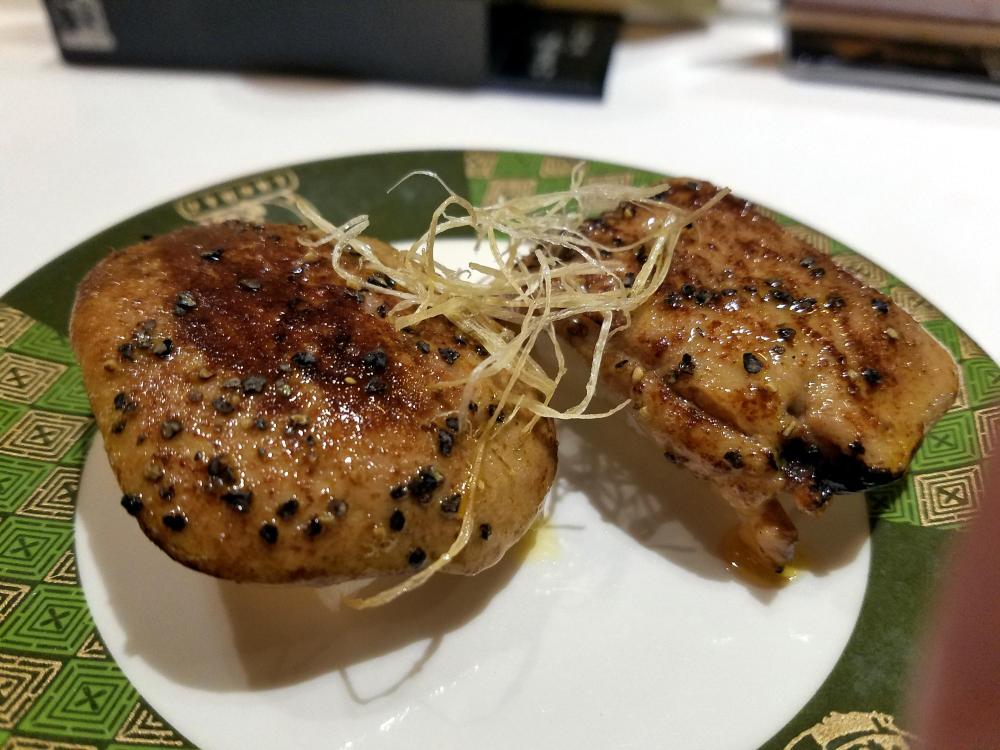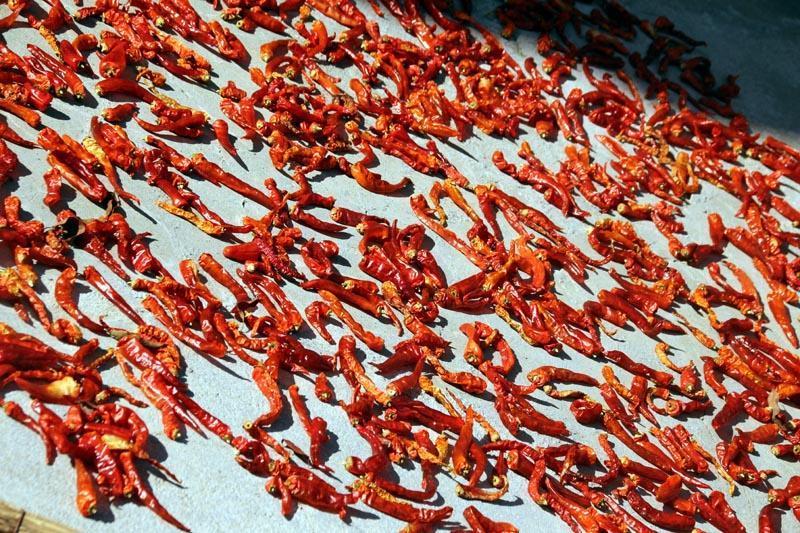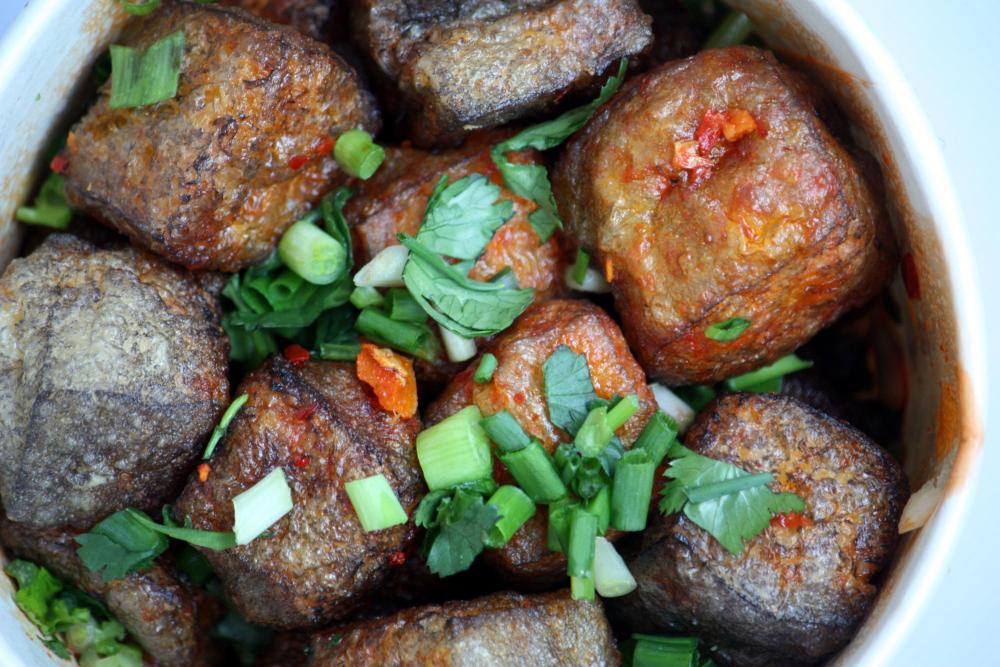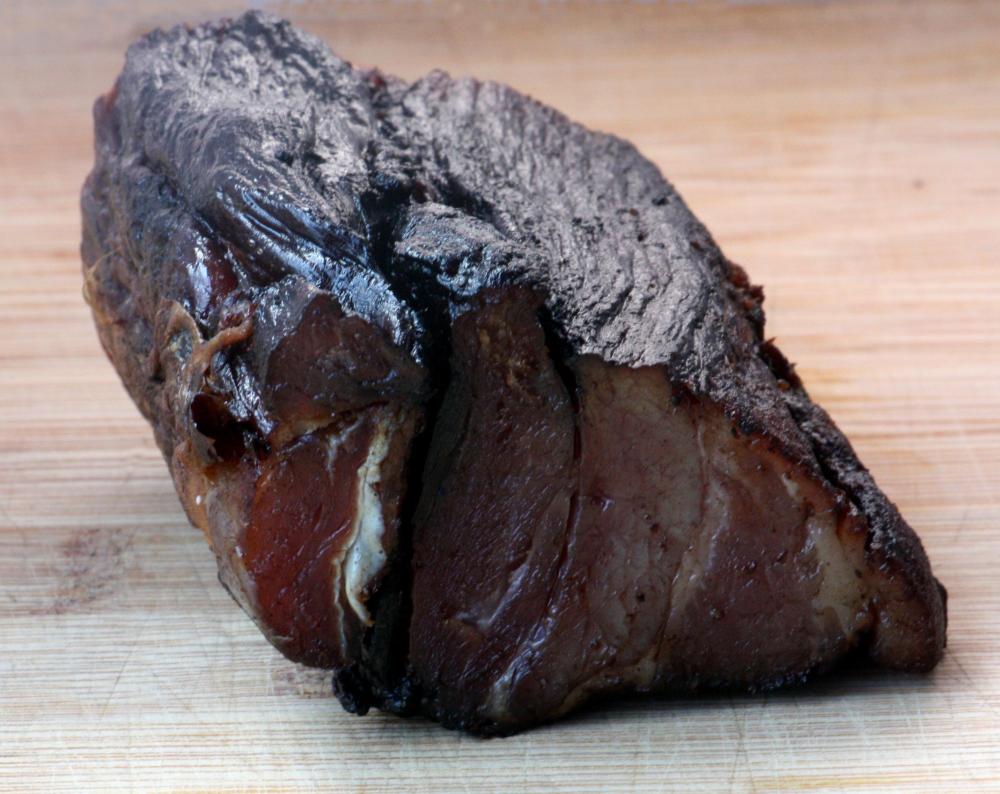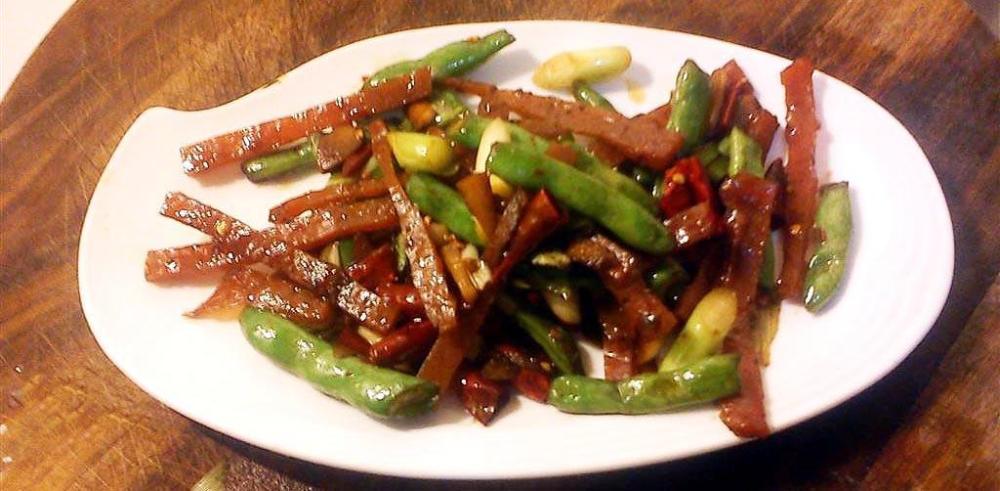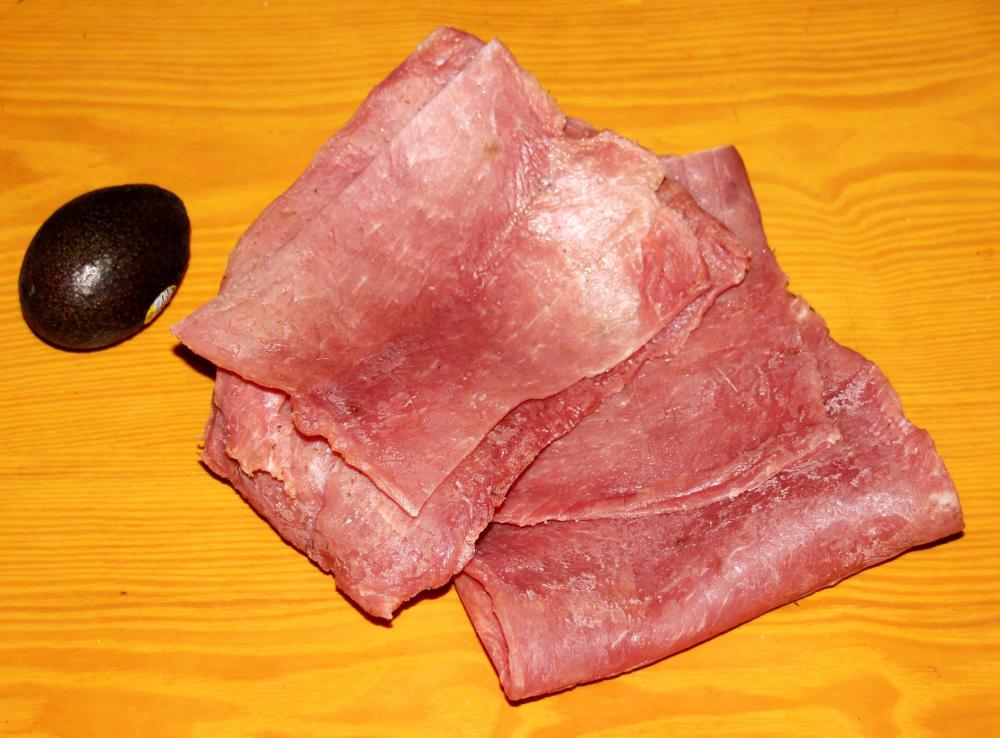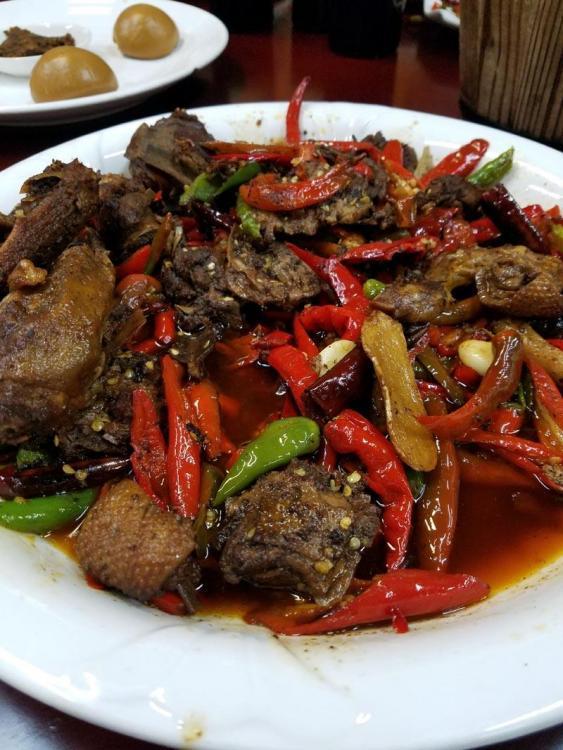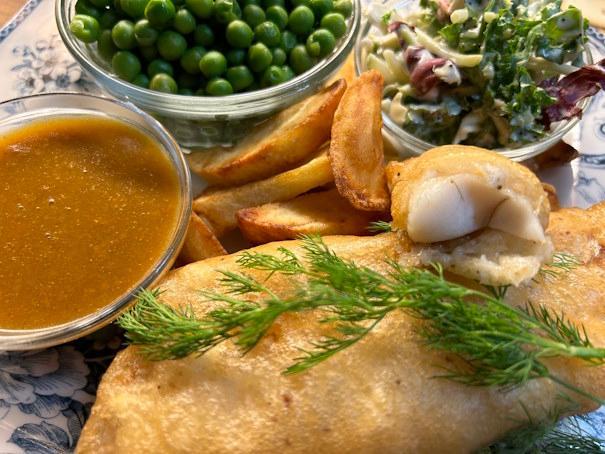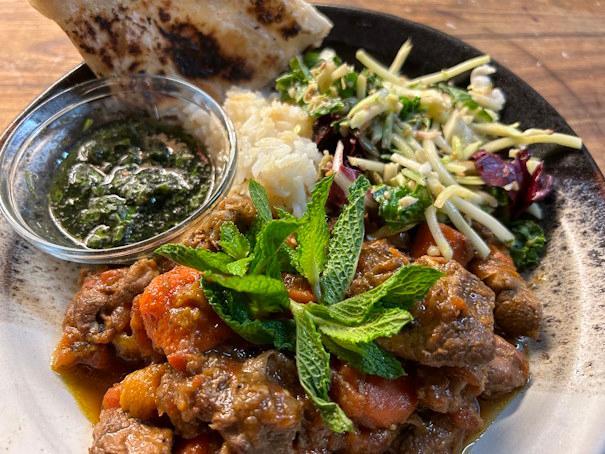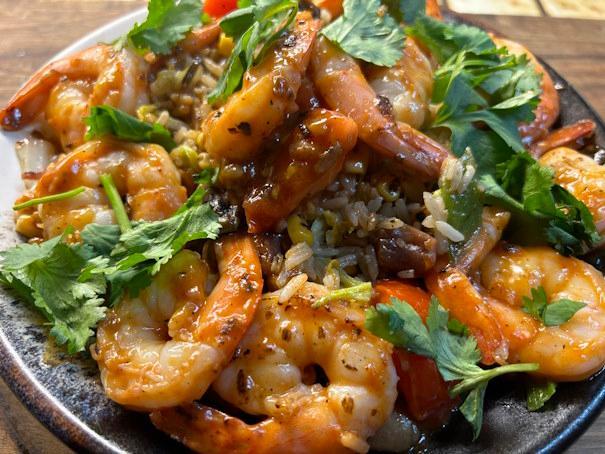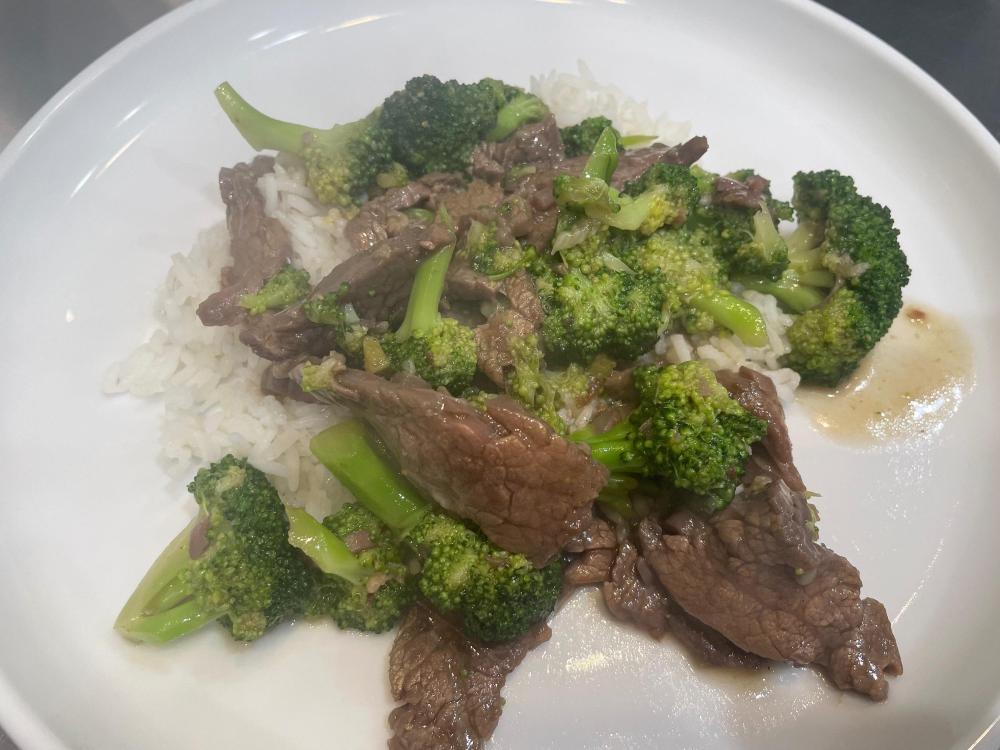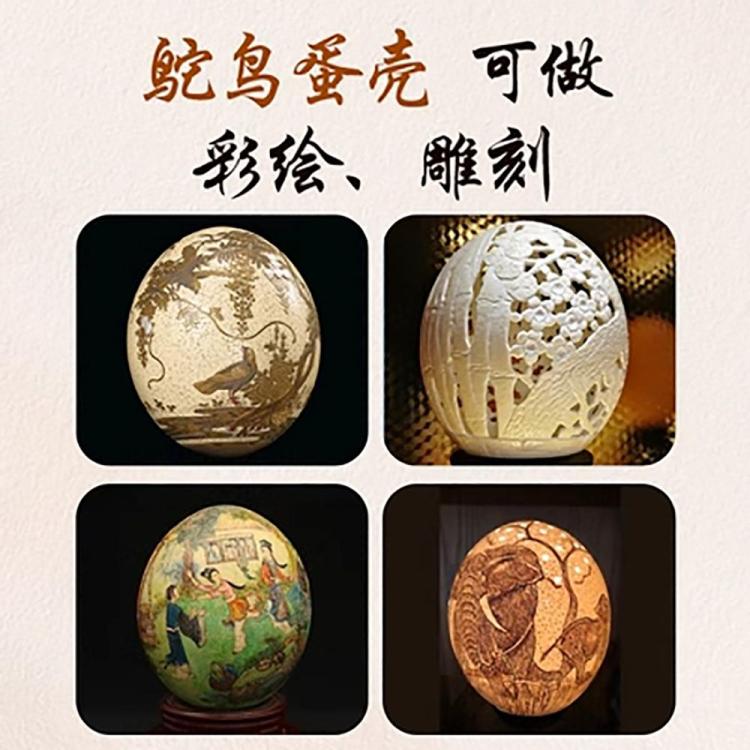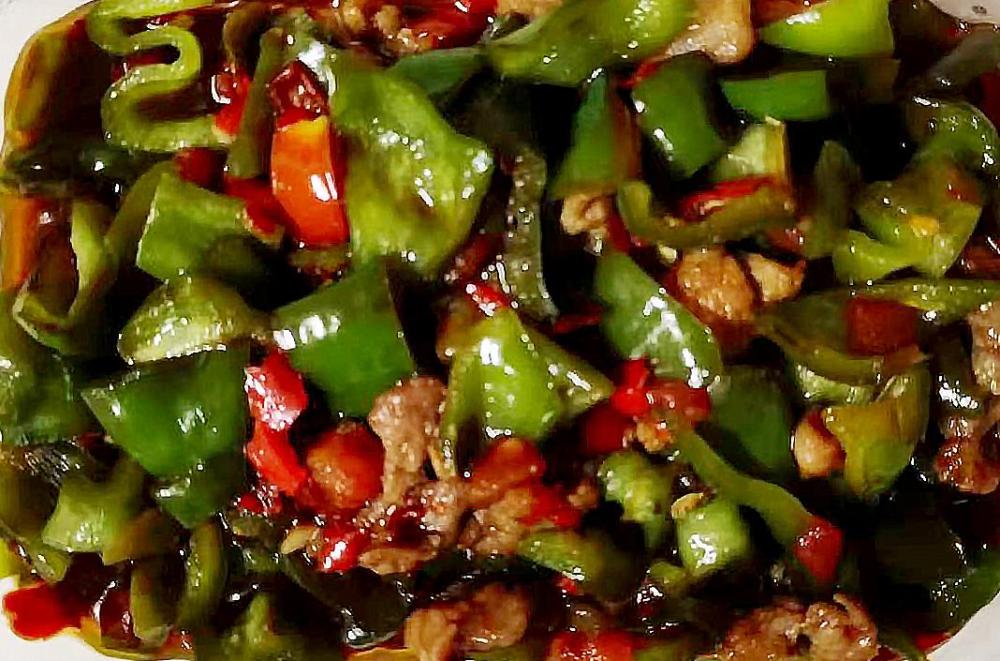Search the Community
Showing results for 'wok'.
-
Needed a quick one wok meal tonight as I was busy working on Char Siu Yaki Udon with various veg, beef and shrimp Was not as warm as I had hoped: -18C, but I was fairly well sheltered out in the backyard. Had marinated slabs of pork sirloin chops, and cooked them in the Big Easy! Diced them up, cooked in hoisin and chicken stock, and ready to make baos tomorrow!
-
Is this spicy bean sauce/là dòubàn jiàng/辣豆瓣酱)?
Ranger3115 posted a topic in China: Cooking & Baking
We are gathering ingredients for The Woks of Life's Taiwanese Beef Noodle Soup. One of the ingredients is Spicy Bean Sauce (辣豆瓣酱, Là dòubàn jiàng). Is the pictured package, offered by a local Chinese market, Là dòubàn jiàng? -
I anticipated someone asking this. First, I must say my kitchen and the average Chinese family's kitchen probably differ. I cook western food about 25% of the time which my neighbours don't. Different cuisines; different techniques; different tools. For example, the most used tools, maybe the only tools in a Chinese kitchen are a wok scoop/spatula, a ladle and a strainer which normally hang on the wall beside the burner unit. Mine hang there, too for easy access, but my collection of 'essentials' is wider. Here is my kitchen wall in the rental before last. The strainer on the left, the wok scoop on the right and the ladle right of centre would be enough for my neighbours. Most wouldn't even know what the others are for, especially the microplane. One tool is missing, I notice. My fish descaler. Must have been a fish night. Smaller items usually sit on countertops in containers like this. This one is about 8 inches tall. It usually contains large spoons, a meat mallet, poultry shears etc. I also have a smaller one for teaspoons etc. I have three of the larger ones, but my neighbours probably just the one. I'm a bit of a gadget addict. Chopsticks live in dedicated boxes, either wall mounted or free-standing. Image from online shopping site, Taobao Knives and one of my sharpening steels are in a couple of knife blocks like this. The other steel is hanging on the wall. Image from online shopping site, Taobao OK. I'm a kitchen knife fetishist, too. My neighbours make do with a cleaver and maybe a paring knife. I like this system My tools are always to hand* and I don't need to go rummaging in drawers when I need something. At the same time, I see some advantages to drawers. I guess it's what get used to that matters in the end. * They aren't to hand at the moment. Emptying boxes with a (healing) broken back is a slow process. A friend is coming tomorrow to help.
-
I got a large pork shoulder with making carnitas in mind but Charlie wanted it cut up for spicy pork bulgogi so that is what I did. I don't know why it turned out so dark. It should have been red but it wasn't burnt. It tasted like it should. Maybe it was the cast iron grill that is the cause. It's going to take a long time to get it cleaned up. Next time I'll use the wok. This is about a third of the whole. The rest is portioned out and in the freezer.
-

Restaurant Food Fashions or Gimmicks
Maison Rustique replied to a topic in Food Traditions & Culture
I have an aversion to eating food that is on the table. Even if it is on paper. I would hate that. And it sure doesn't leave you much room for your drinks or whatever. In that last photo where they are dumping the wok, I see the corner of a phone right next to it. I'd be having a heart attack if that was my phone. -
I know it's hard in the restaurant business and many are struggling. Some desperately seek gimmicks to set themselves apart from the competition. Few work for long. I've seen many here come and go. Here in China, a recent fashion has arisen for this bizarre type of service. Instead of plating the food, the server brings a whole wok full of food and tips it into the centre of the table, which is covered in paper. Seafood is the most common I've seen. These screen grab images are from Douyin, the heavily censored version of Tik-Tok used in China. I have the videos but can't post them at the moment. More censorship. Dig in! I'm sure there are others!
-
Yes, the red in my meal was chilli peppers. There was no potato though. It was a delivery meal, so I didn't cook it and I can't remember what that white piece at approx 7 o'clock in my picture was. If you forced me to guess, I'd say it was a clove of garlic. Good excuse to order it again, just to check! I find The Woks of Life website a very unreliable source of information.
-

Hi I am learning to cook so I can make vegetables taste good
liuzhou replied to a topic in Welcome Our New Members!
Chinese food uses a lot of vegetabes but almost always with meat included, too. Vegetables are stir-fried, often in lard (pig fat). I realise you are not necessarily looking for vegetarian food, though. However you might want to read this article first for background. As to cookbooks as mentioned by @Katie Meadow, I recommend you have a look at Every Grain of Rice: Simple Chinese Home Cooking (eG-friendly Amazon.com link) by Fuchsia Dunlop. This covers simple family cooking as actually found in China. My neighbours would recognise every dish. I agree with Katie that a good wok, preferably carbon steel (and definitely not non-stick), is the way to go. If you have a Chinatown or Chinese market nearby, they are usually the best place to buy them. Don't worry so much about high heat - Chinese home cooks manage well with normal domestic stove tops. Good luck! If you have any more questions, feel free to ask. -

Hi I am learning to cook so I can make vegetables taste good
C00kman replied to a topic in Welcome Our New Members!
I have been reading up and I have purchased "The Wok" by Kenji López-Alt. I have his recommended burner and a stainless steel wok. So I am good to go there. I still am very much a novice at that sort of cooking though. I also been experimenting with various instant pot recipes for SE Asia cooking. I am in the North Carolina in the US. -
Hi I am learning to cook so I can make vegetables taste good
Katie Meadow replied to a topic in Welcome Our New Members!
If you have read any of @liuzhou 's recent posts you already know that Chinese food is almost endlessly varied. However, I believe it is possible to learn to make a relatively easy and basic stir-fry using vegetables that are available to you and with a small investment in basic condiments. The trick is that a decent wok and a relatively high flame are essential. Many people try to make stir-fry in a saucepan with inadequate heat, and that's really just a sauté. Personally a stir-fry is my go-to easy and fast meal, and the best way I know of to combine different vegetables. And one technique or method can get you started. There's a short learning curve when it comes to what ingredients to add when, but that will make sense quickly. And you do need to prep all ingredients before cooking, because you will probably need to work fast. Maybe someone else can suggest books that get you into Chinese cooking; I've honed my technique from various sources, and can't think of just one book to recommend for a beginner. Where do you live? What kinds of ingredients are you most likely to find near you? That might get you more specific responses here. -
东北 Cuisine – North-Eastern Cuisine Part One - 龙江菜 (lóng jiāng cài) Heilongjiang Cuisine In this post I’m heading to the frozen north, not in person, but in terms of describing as much of China’s various regional cuisines as I can. 东北 (dōng běi) literally means ‘east-north’, the Chinese way of saying north-east and comprises the three provinces of 黑龙江 (hēi lóng jiāng), Heilongjiang, 吉林 (jí lín), Jilin and 辽宁 (liáo níng), Liaoning. The area is in China’s north-eastern corner bordering Russian Siberia, Mongolia and North Korea. It’s damned cold. Until recently, this cuisine wasn't well known even in China and I guess still isn't abroad. But that is changing and the area is becoming fasionable. That said, there are a couple of dishes whose names you may know if not the original renditions. This area was what some people still call Manchuria (Chinese: 滿洲), a term many Chinese find distasteful as it reminds them of them of the puppet state, 满洲国 (mǎn zhōu guó), in Mandarin; manchou kuni in Japanese) which Japan set up after invading China in 1932 and annexing the area under the puppet-leadership of Puyi (溥仪 – pǔ yí), the last Chinese Emperor who had abdicated as a child back in 1911. He was dragged back basically as a hostage. He was imprisoned by the communist regime after 1949, but released after ten years. His story is the subject of Bertolucci's biopic “The Last Emperor”. He lived out his life as a gardener and died in Beijing in 1967. The Japanese were booted out in 1945 at the end of World War Two. In 1949, Mao’s new government changed the name and divided it into the three new provinces. Puyi - The Last Emperor - Public Domain Image I’ll take the three provinces in turn, heading north to south. Heading south is always best in the northern hemisphere, I find. Heilongjiang is named after its principal river and means ‘black dragon river’. It is bone-chillingly freezing in winters with temperatures falling to -40℃ / -40 ℉. The capital, 哈尔滨 (hā ěr bīn) Harbin holds an ice festival every winter. I’ve never been even in summer. I don’t do cold. Heilongjiang borders Siberia (which, perversely, I have been to). That probably explains why I don’t go back. The 龙江菜 (lóng jiāng cài) as they call their food is, as in all of Dongbei, is hearty and the portions famously ample. Also, like most of northern China they traditionally use wheat rather than rice, in the form of breads and especially dumplings. This is where 饺子 (jiǎo zi) Jiaozi originated. The Japanese stole them and called them 餃子 (gyoza), their attempt at pronouncing the Chinese and using the Traditional characters, no longer used in mainland China. One of my favourite places in town is 哈尔滨饺子王 (hā ěr bīn jiǎo zi wáng), a family run restaurant whose name means ‘Harbin Jiaozi King’. The family is from Harbin and most people agree their jiaozi are the best. They sell thousands of handmade jiaozi every day. Harbin Jiaozi King - Liuzhou Harbin Jiaozi King's Wares Heilongjiang also use potatoes, sorghum and c⊘rn as starches, the latter being another good reason for me never to go there! 地三鲜 (dì sān xiān), is a favourite here. It literally means means ‘earth’s three delicacies’ and is stir fried potatoes, hot green peppers, and eggplant with a moderately sweet soy sauce. It is served with hearty meat dishes. Earth's Three Treasures Harbin is also the origin of sweet and sour pork. Known locally as 锅包肉 (guō bāo ròu), this is, in all likelihood, rather different from the offering in your local Happy Wok, or whatever. Not nearly so sweet and certainly doesn’t glow in the dark. Larger slices of pork are coated in potato starch (not batter) and double fried. First at a lower temperature, then again in hotter oil to crisp it up. Stop there! At least that is what the Harbinites did until some Russian traders requested a sauce with it and the modern version evolved. The sweet comes from a moderate amount of sugar – around 100 grams / 3½ ounces to 500 grams / 1lb meat and is balanced by 150 ml / 10 tablespoons of rice vinegar. The sauce also contains rice wine, preferably Shaoxing, garlic, ginger and soy sauce. Guo Bao Rou 木樨肉 (mù xī ròu), Mu Shu Pork is also local, but also not much like that found in the west. And it is emphatically served with pancakes, but with rice. And it isn’t mu SHOO either, but xī, which is pronounced sort of like ‘she’ as the pronoun for females. The mù refers to the wood-ear fungus which are an essential element of the dish; the xī means osmanthus, referring to the aroma; and ròu is the meat. Mu Xi Rou (Mu-Shu Pork) Heilongjiang is also noted for its goose farms. Most of that is sent south to Guangdong and Hong Kong to be roasted as famous in Cantonese cuisine. What I get are the livers, both natural and as foie gras. Goose Liver and Toast Heilongjiang Foie Gras Also available are these rather good goose liver and pork sausages. and, bizarrely given the history of ther region and Japan, the local livers are available in Japanese restaurants there as liver sushi. The restaurants are all Chinese owned. (Anyway, sushi originated in China). In the far north-west of Heilongjiang, bordering Siberia is 兴安岭 (dà xīng ān lǐng) Daxinganling, a mountain range and wooded area. The area has an average annual temperature of -2.8C /27F and in the long winters gets as low as -40C / -40F). Summer is a mere two months long. The area is known for its mushrooms and other wild foods. Particularly prized are 元蘑 (yuán mó), Armillaria mellea, wild honey mushrooms which are made into 小鸡炖蘑菇 (xiǎo jī dùn mó gu) a delicious chicken and mushroom stew. Stewing is not, as I’m sure you know, a common Chinese technique, but Heilongjiang has many examples – blame the weather. Incidentally these mushrooms also grow in America so you needn’t visit the frozen north to sample it. I buy them dried here and they rehydrate well. Chicken and Honey Mushroom Stew Rehydrated Dried Honey Mushroom. The closeness of Russia and the long-established trade relations in Heilongjiang mean that the cuisine has a noticeable Russian influence. Sold all over are 哈尔滨红腊肠 (hā ěr bīn hóng là cháng), Heilongjiang red sausages. These were introduced to China from Russia at the beginning of the 20th century. It resembles a smoked Polish or Lithuanian sausage much more than the well-known lapcheong Cantonese sausages. They are relatively low in fat and smooth textured. Me likes 'em. These are often served with 大列巴 (dà liè bā), a type of rye bread with raisins which was also introduced by Russia in the 1950s. Harbin Red Sausage Da Lei Ba - Russian Style Raisin Bread made in Harbin. Next up, Jilin which I have visited – in summer!
-
湘菜 (xiāng cài) - Hunan (湖南 - hú nán) cuisine After a year in Xi’an, I moved south to a small city in Hunan in south-central China and fell in love. At first, I hated where I was living, but soon acclimatised. What took me no time at all to love was the food. I had no idea such food existed! What is this? Such wonderful food. Almost 30 years later, I remember every detail of the first meal I ate there. I was home! It remains my favourite Chinese cuisine. I revisit often. Hunan food is known for its extravagant use of fresh and, less often, dried chillies, usually red but also green. In summer every flat surface - basketball courts, railway station platforms, roads and sidewalks - are covered in chillies drying in the sun. I remember a chilli-averse British friend coming to visit and telling me she wanted the fried noodles in one hole-in-the-wall restaurant near my home, but without chilli. I explained to the cook, who gave me a strange look as if to say “that will never work”. She knew me well and knew I have no problem with chilli heat. However, she did her best and wokked up some fried noodles without chilli. My friend still complained. It seemed that after decades of use, the cook’s wok was irretrievably imbued with the heat of the spice. As I’ve mentioned on eG before, Hunan women, especially the younger ones, are often called 湖南辣妹 (hú nán là mèi), literally ‘Hunan Hot Sister’ with the ‘hot’ part referring to the capsicum, 辣椒 (là jiāo) but also the sexual innuendo doesn’t go unnoticed. The singing group, the Spice Girls are called 辣妹 (là mèi) in Chinese. Another important feature of Hunan food is the use of smoke. Hams (腊肉 - là ròu) are usually heavily smoked. as are fish and other meats. The cuisine is often sour – pickles being commonly used, not only on vegetables but also pork and fish. Robust, pungent, spicy flavours rule. Hunan smoked ham Hunan smoked ham Hunan smoked fish The cuisine is usefully split into three styles. 湘江菜 (xiāng jiāng cài), Xiang River cuisine, 洞庭湖菜 (dòng tíng hú cài), Dongting Lake cuisine, and 湘西菜 (xiāng xī cài), Western Hunan cuisine. The first, Xiang River cuisine is that centered on 长沙 (cháng shā), Changsha, the capital of Hunan in the east of the province. The river flows through the city centre. The food is more oily than other areas of Hunan but is fresh and aromatic. Included in this sub-cuisine is the small town of 韶山 (sháo shān), Shaoshan, Mao’s birthplace, as mentioned above. Here, Chinese tourists flock to see his former residence and the Mao museum then go on to eat his favourite dish of 红烧肉 (hóng shāo ròu), red braised pork, also mentioned in the last post. Changsha is also a bit over Mao-centric (he studied there to be a teacher and this was where he took up communism). His favourite restaurant is still there, complete with Mao posters all over the walls, but also with photos of him in the restaurant to prove the authenticity of the claim. As I remember, they didn’t look Photoshopped. Changsha is well-known for its 臭豆腐 (chòu dòu fu), Stinky Tofu. This is fermented tofu in spices until it turns black and yes, stinks. However, like some stinking cheeses, when you get it past your nose and into your mouth, it tastes delicious. Changsha Stinky Tofu Dongting Lake is to the north of Hunan (Hunan literally means ‘south of the lake’) and supplies much of the province’s seafood, so that prevails. The area also produces a lot of chicken, also a favourite. But the best thing I ever ate there was lotus seeds in sugar, even though I have a very un-sweet tooth. I lived in the west of Hunan, one of the last parts of China to be taken by the communists under Mao. It was, in the past, a wild place ruled by warlords and full of bandits. It is a beautiful part of the world and very mountainous area (the floating mountains in the movie Avatar were inspired by the real mountains there) and almost every valley has a different dialect or language. It is home to several of China’s ethnic minorities, especially the Miao and Tujia, but also Dong. This is where I took all the photos in the linked topic below. It has the spiciest food in Hunan, probably spiciest in China and is known for its sour flavours. I showed many West Hunan dishes a few years ago in this topic, so I’m not going to have many here, but there are a few I feel I must mention. 芷江 (zhǐ jiāng) Zhijiang town in Zhijiang Dong Autonomous County was where the Japanese formally surrendered in China at the end of World War Two and is the site of what they call “Memorial Hall of the Victory of the Anti-Japanese War and the Acceptance of the Japanese Surrender”. It also is home to The Flying Tigers Memorial Hall. Although these attract many visitors, it attracts me for its signature dish, 芷江鸭 (zhǐ jiāng yā), simply the best duck dish in the world to my tastes. When I go back, as I do as often as I can, this is what I go for first. Zhijiang duck Another, very local speciality is 沅陵晒兰 (yuán líng shài lán), a type of ham only made in 沅陵 (yuán líng), a small town in Huaihua (怀化 - huái huà) prefecture. This mild, unsmoked salt-cured ham is made using a local breed of black skinned pigs. It is to die for. Usually cut into strips and stir-fried with chilli (of course), garlic and green beans. Shai lan ham Shai lan with green beans Once dish you will struggle to find in Hunan is General Tso’s Chicken as sold in every American Hunan restaurant – perhaps every American Chinese restaurant. It is almost unheard of in Hunan and when the inventor tried to introduce it there the locals were deeply unimpressed. Hunan ain’t sweet. But I love the place. Fuchsia Dunlop's Revolutionary Chinese Cookbook - Recipes from Hunan Province (eG-friendly Amazon.com link) comes highly recommended,
-
No question long-term induction the way to go. I’ve tried a couple of the 120 V plug-in models. These get overwhelmed with anything more than say half a pound of protein also compared to a gas wok. The induction woks seem to have a smaller hotspot as well. I would like to get a bigger induction wok burner the question is what? My gas outdoor wok is 18 inches and it’s great other than in Calgary winters or when there’s lots of insects it’s time to move indoors with it. I have a control freak, which spoils me in terms of flexibility and temperature control. I’m not sure if I can find an induction wok with the same amazing technology. Garland has a neat system that uses three temperature sensors as opposed to the one essential one in most induction burners that looks promising. Anyone have any experience with it?
-
Spent a few days in Winnipeg while second was working in the city. He and family moved to St John's, and he works remotely. It's great that the company will fly him back, 3 times this year for big project sessions. Lamb is his favourite meat, but the rest of his family are not fans. I stock-pile lamb chops when Safeway has "reduced price" stickers, sol I sous vide 20 and took them into the city (finished on top of stove before supper). We were staying with our daughter and s-i-l, so lots for everyone with a couple left over for lunch. He went home happy! We were too busy visiting and eating for pictures! Got home just before weather turned nasty with snow, freezing rain, and icy roads. TransCanada was closed from just west of Brandon to Winnipeg by supper time! Supper was quick: Sauteed shrimp and fried rice My wok needed a good scrubbing, so it was needing a re-seasoning. Fish and chips (with curry gravy) filled the bill! Seems we never get tired of lamb! Cut up a small boneless lamb leg and braised with Moroccan spices in the oven. Made the house cozy and fragrant! Late supper last night! We had 9th birthday cake with our youngest granddaughter last night. Came home to Shake'n'Bake chicken, delicious cabbage rolls made by a pal, and steamed green beans. I had it all cooked before we went for dessert!
-
Beef and Broccoli from Woks of Life - velveting of beef with a mixture of baking soda, oyster sauce, cornstarch and oil. Broccoli briefly blanched before everything was stir fried with a sauce made from chicken broth, dark and light soy sauce, oyster sauce, sugar, garlic, ginger, roasted sesame oil, cornstarch and white pepper.
-
It's chilly this morning and I don't feel like getting out of bed until my husband turns on the heat, so.......it's time for a rant! You've heard it before, of course, but that so-called lasagne was one of the few times I've had to confront in real life the vegan substitution problem. My dwindling circle of friends as I get older are omnivores and vegetarians, but not vegans. When I think over my (also dwindling) repertoire of hits I realize that quite a few of them are, in fact, totally vegan. Chinese stir-fries top the list if you like a variety of vegetables and greens and tofu. And it's easy, although good equipment like a wok and a range with strong BTU's helps. As @liuzhousuggests, Italian pasta dishes also offer lots of options. Besides pesto, if you don't make it with cheese, the variety of meatless tomato sauce dishes is wide. I particularly like to add garlicky sautéed cauliflower or artichokes. Grated hard cheese for a topping can be optional for non-vegans at the table. Casseroles using a variety of grains and veggies baked in the oven are also no brainers, and can be really satisfying. And curries! Any number of great vegetable curries can be made using coconut oil instead of butter. Cauliflower and tomato curry is a favorite of mine. Skip the raita and serve it with fresh cooling fruit. Grain salads are excellent. I have one I adore that's made with bulgur wheat, swiss chard, olives and pine nuts, with a tangy shallot dressing. Cuisines that don't rely on butter offer a lot of choices. None of the many vegan dishes I often make don't require a banner headline advertising that they are vegan. They are not called burgers or lasagne. They just don't include animal products nor do they try to recreate versions of dishes that showcase eggs, cheeses or other dairy or meats. My mother always made her potato salad with an olive oil dressing, like for a nicoise; she was not a fan of mayo. For soups or beans, make a really good vegetable stock. That alone goes a long way toward flavor. Many "cream of" green soups are great without the cream. Croutons fried in garlic olive oil to garnish soup cannot be overstated! Okay, done. .
-
It was about 20 years ago. A friend was leaving China for the USA to study, so a farewell party. The event was held in a restaurant owned by a mutual friend who kindly gave me access to the kitchen. The omelette (plain) was made in one of their huge woks. Woks are not really suited to omelette making as the egg naturally pools in the bottom, so I had to keep swirling it until the egg set around the edges of the pan – back-breaking work. The hardest part was then folding it. I remember I took three of us to flip it over on itself. It was then served on a huge banquet platter, presented intact, then cut into slices with a machete! Someone did take pictures but it was before the Instagram age whereby people photograph every piece of trivia they come across, so I don’t have a copy. Also most of the attendees are long gone from China (two long gone from the world, alas), but I can ask around and see if anyone has one. The friend settled in Seattle after her study and is still there. She doesn’t have a copy, either. Everyone did find it hilarious but assumed it was just made with lots of separate chicken or duck eggs, but I had kept the now empty shell as evidence. Both emu and ostrich egg shells are sold here pre-blown (no, you don't get the contents) as curios or ornaments, usually intricately and beautifully painted or carved. Here are a couple of images from Taobao, Chinese largest online shopping site. Painted Emu Egg Painted and Carved Ostrich Eggs.
-
Homestyle Tofu from “Woks of Life” with wok-fried tofu, dried wood ear mushrooms, red and green peppers, scallions, ginger, garlic, star anise and a sauce made with cornstarch, oyster-sauce, Shaoxing wine, light and dark soy sauce and sugar
-
For "Japanese movie night" I was more hoping for Ringu. Can't quarrel with sake though. Dinner here last night was dumplings on a bed of ken-cut cabbage, steamed in my new bamboo steamer and German wok.
-

Absurdly, stupidly basic cooking questions (Part 2)
blue_dolphin replied to a topic in Food Traditions & Culture
Should you choose to use the steamer in a stock pot or skillet rather than a wok, the ring can be used to hold the steamer above the bottom of the pot so the steaming water won’t flood your food. Not usually necessary if using a wok. -
Cafe Spice Namaste Lamb Dhansak This is the traditional dhansak recipe you can find on the greedy gourmet website https://www.greedygourmet.com/recipes-for-diets/gluten-free/dhaan-saak/ I have compared it to that in Cyrus Todiwala’s Cafe Spice Namaste cookbook, first published in 1988 from where the online recipe originated, and I have corrected the text to rectify any errors and omissions on the website. There is a lot of work to this dish, maybe not for the faint hearted, but if you want to prepare something with the Wow factor for friends and family you could spread the preparation of the various components over several days or even weeks with the aid of a freezer. Ingredients Dhal 100g toor daal 50g channa daal 50g moong daal 100g masoor daal 1 small aubergine, diced 100g pumpkin (peeled weight), diced 2 tbsp coarsely chopped fresh dill 1 colcasia leaf (arbi), if available 50g fresh fenugreek leaves, or 1 tbsp of dried leaves 6 tbsp prepared tamarind pulp or paste or 2 tbsp concentrate 100g jaggery 2 tbsp chopped fresh coriander stalks 2 tbsp chopped fresh mint stalks Salt, to taste For the Wet Masala 5cm piece of cinnamon stick 6 cardamom 6-8 cloves 2 tsp cumin seeds 10 peppercorns 1 heaped tsp coriander seeds 8-10 large dried red chillies 3 x 2.0cm pieces fresh ginger, roughly chopped 10-12 garlic cloves, roughly chopped 30-50g fresh coriander, stalks and leaves Dry Masala 3-4 cardamom pods 3-4 cloves 2-3 star anise 1 heaped tsp cumin seeds 8-10 black peppercorns 2-3 dried red chillies 2 tsp dried fenugreek Lamb 2-3 tbsp oil 500g boned leg of lamb, in 2cm cubes, ask your butcher to saw up the bones and give them to you. 150ml water Chopped fresh coriander and mint to garnish Salt Pulao 5 tbsp vegetable oil 4 onions finely sliced 1 tbsp chopped fresh mint 1 tbsp chopped fresh coriander 2.0cm piece of cinnamon stick 3-4 cardamom pods 3-4 cloves 4-5 star anise 500g basmati rice, washed and drained About 2 tsp salt to taste Kebab 1 onion, very finely chopped Oil for frying 500g fresh lean minced lamb 5cm piece fresh root ginger, very finely chopped 6-8 garlic cloves, very finely chopped 2 green chillies, very finely chopped 1 tsp ground cumin 1.5 tsp ground coriander 0.25 tsp ground turmeric 0.5 tsp chilli powder 2 tbsp chopped fresh coriander 2 tbsp chopped fresh mint 1 tsp lemon juice 3 slices of brown or white bread, soaked in a little water, then squeezed out into a ball Salt to taste Kachumber 1 large onion, finely sliced 2 tsp chopped fresh coriander 10 fresh mint leaves, chopped 1 green chilli, finely chopped 1 small tomato, deseeded and finely chopped 1tsp white vinegar Salt, to taste Instructions Dhal Wash all the pulses and transfer to a large heavy-based saucepan. Add water to cover by 2.0cm, then add all the remaining ingredients and bring to a boil. Reduce the heat and simmer, scraping the bottom of the pan regularly with a wooden spatula. When the lentils are fully cooked, puree the entire contents of the pot until smooth, then cover and set aside. Lamb First prepare the masalas. Wet Masala Heat a large heavy based frying pan or wok, add all the ingredients except the fresh coriander and roast gently for about five minutes, stirring frequently. When the chilies and spices look roasted (i.e., they have changed colour slightly but are not actually discoloured) remove and grind to a smooth paste in a blender, adding the fresh coriander and just enough water to process the mixture. Dry Masala Roast all the ingredients gently in a wok or skillet, stirring regularly. When the spices have changed colour, smell gorgeous and look roasted, remove from the heat and allow to cool. Transfer to a grinder and process into a fine powder. Heat the oil in a large heavy-based saucepan, add the lamb and the bones and sauté on a high heat until the meat is well coloured. Add the wet masala and cook until you see the oil separating along the sides of the pan. Add the 150ml of water, check salt, and cover tightly and cook on a medium heat for 40-45 minutes, stirring regularly and adding a little more water if it looks too dry. When the lamb is cooked and you have a nice thick, rich gravy, stir the mixture into the puréed dhal. Add half of the dry masala then taste. If it is to your liking, save the rest of the masala to serve with other lamb dishes. Or add the rest of the masala, a little at a time, tasting as you go. This is your Sak. Pulao Heat the oil in a large pan and add half the onions, fry until crisp and golden. Drain well on kitchen paper and set aside with the mint and coriander, they will be used to garnish the rice just before serving. Add the spices to the casserole and cook over a fairly high heat for 2 minutes, stirring until dark and swollen. Add the remaining onions and cook gently, stirring frequently until they are a deep brown colour. Add the rice and cook over a medium heat for 5-6 minutes, turning the rice regularly so that all the grains are evenly heated. Add the salt, the pour in enough hot water to cover the rice by 2.0cm. Stir for a minute, cover tightly and cook over a very a low heat for 15 to 20 minutes. Check on the rice every now and again, stirring from the bottom up with a flat wooden spatula. If you need more water add it a little at a time. The pulao should take approximately 15-20 minutes to cook. When the grains are cooked, set aside but do not uncover the pot. Sheek Kebabs Fry the onion in 1 tablespoon of oil until soft. Remove from the heat and leave to cool. Mix with all the other ingredients in a large bowl until thoroughly blended. Cover the mince mixture and chill in the refrigerator. Roll the lamb mixture into 2.5cm (1in) balls. Deep fry the kebabs or, if preferred, place them on a greased baking sheet and bake in an oven preheated to 200°C/400°F/gas mark 6 for about 20 minutes Kachumber Mix all the ingredients in a bowl. Serving the Dhansak Reheat the rice, lamb and kebabs if necessary. Garnish the Pulao with the fried onions, mint and coriander, then dot with the kebabs over the top. Garnish the Sak (meat and lentils) with chopped fresh coriander and mint. Serve Kachumber on the side.
-
I think my range is on the way out.....decisions decisions
Deephaven replied to a topic in Kitchen Consumer
Glad you found a fix for your current unit. In the future though I suggest a more serious look at induction. I have bluestar and the two critical things you cite are definitely the strength of induction and not the bluestar. Even on the 8k burner with a deflection plate and an extra 2 stacked grates you can't simmer on the range. I gave up and do it in my oven. Wok cooking as well. Compared to other gas ranges (wolf/dacor directly tested often) it is brilliant but even the cheaper wolf induction destroys it. Shocking how much less "boiling" proteins do on the induction. After a bunch of testing my bluestar is about to get sold. It's a 36" range top, but about to be a 36" induction. Was a hard swallow as well since I have a near complete collection of deherrelin copper. -
I have a blue star (for another 3-4 weeks) and a wok. Still have to be rather careful on batch size and over shooting either way. Moving to a wolf induction which in testing with other things responded significantly faster than the blue star. Going to miss the gas, but not the heat and splatter that comes with it.
-
Trying to put a PID controller in the loop by using a smart induction burner and a probe (or other thermometer) probably won't deliver great results. As soon as food hits the oil, the temp is going to drop hard and unless you're frying something really thick like pieces of chicken, your food probably won't be in there long enough for the heater to fully recover the difference. I usually fry in a dutch oven on a nice 1800W induction burner (Vollrath Mirage Pro) and even with the power cranked to 100, the oil temp never gets back up to its starting temp during the fry process. I sometimes start with hotter oil to compensate (like starting around 415F for the final fry where my target frying temp is around 375F, and even then I have to jack the power to 100% to make sure the oil temp doesn't drop too low. This is frying in reasonably sized batches. My preferred method is to use a wok over a high powered wok burner, but that's an "outside only" situation. If you're lucky enough to have a high output gas burner indoors (like on a Blue Star or whatever) frying in a wok might be the best way to fry at home. At least if you have good extraction.
-
1997, Western Hunan, (湘西 - xiāng xī). I fell in love with this simple dish. The restaurant I usually ate it at was run by a couple, him doing the service and her doing the cooking outside the front of their small place, making everything in one wok, one serving at a time. She had a special of the day each day and I was always happy to order this one when it appeared (athough I could order it any day). 青椒肉丝 (qīng jiāo ròu sī), literally green chilli pepper shredded meat - as ever when the type of meat is not specified, it means pork. Although Hunanese in origin, it can be found pretty much all over China and is commonly cooked at home.

